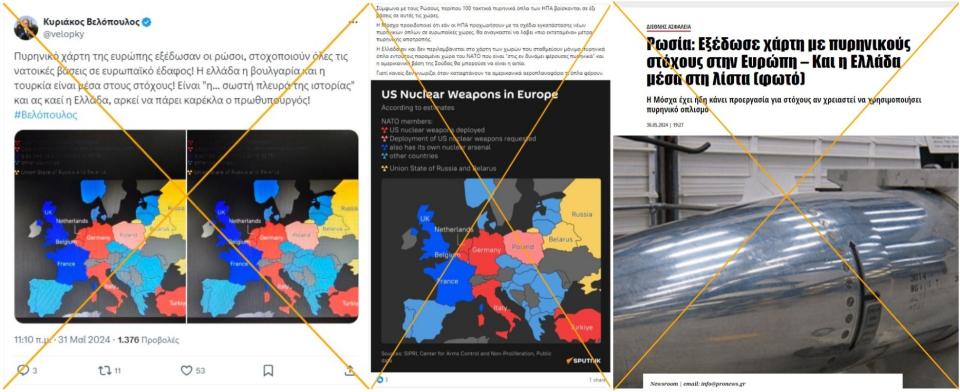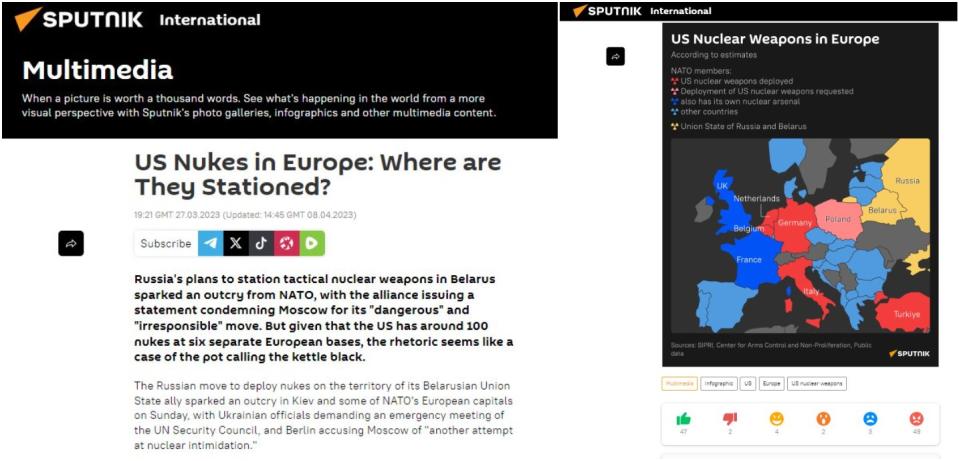The map shows presumed location of US nuclear weapons, not Russian targets
Since the Russian invasion of Ukraine in early 2022, President Vladimir Putin has raised the possibility of an escalation to nuclear war. Against this backdrop, a map circulated on social media in Greece in May 2024 claimed to show Russia's nuclear targets in Europe. However, the original map makes no mention of targets. It was published by the Russian news agency Sputnik in 2023 to show where in Europe the United States is believed to have nuclear weapons. Nuclear non-proliferation experts told AFP that Washington has never confirmed where its nuclear arsenal is located and the map is merely speculative.
Since Russian troops marched into Ukraine on February 24, 2022, Moscow has pointed to its nuclear capabilities and warned it is ready to deploy them in case of an existential threat. On May 9, 2024, Putin said (archived here) that his nuclear forces were "always" on alert. On May 21, Russia announced the start of tactical nuclear weapons drills close to Ukraine (archived here).
Days later, the map falsely claiming to show Russia's nuclear targets in Europe began circulating on Greek social media and websites. It was carried by Pronews.gr -- a site that AFP has already found has shared misinformation(here, here and here) -- with the headline: “Russia: published a map of nuclear targets in Europe -- Greece on the list".
The same image with similar claims was published by other Greek websites (here and here) and on Facebook (here). It was shared on X by Kyriakos Velopoulos, president of the Hellenic Solution political party, and by Nikolaos Papadopoulos, MP of the ultra-Orthodox political party Niki, on YouTube. This post even claimed: "Moscow has already prepared targets if it needs to use nuclear weapons".
However these claims are misleading. The map was published more than a year ago in an article speculating where the US might have placed nuclear weapons; it is not meant to show Russia's supposed nuclear targets. The United States has never officially confirmed or denied the presence of its nuclear stockpiles in any specific location.

Map of suspected US nuclear stocks
Using a reverse image search, the earliest version of the map that AFP could find was in an article published by Russian state-owned media outlet Sputnik on March 27, 2023 (archived here). The European Union considers Sputnik to be a propaganda organ of the Kremlin and banned its broadcasts (archived here) in March 2022.
The Sputnik article with the map was entitled: "US nukes in Europe: where are they stationed?" It appeared two days after Putin announced (archived here) his intention to deploy tactical nuclear weapons in neighbouring ally Belarus. The West criticised the move as sabre-rattling.
The map in the Sputnik article is entitled "US Nuclear Weapons in Europe, according to estimates". This title is included in some of the posts that share the same map with the false claim that it shows Russian targets. The article does not say the map shows Russian nuclear targets but introduces the image with: "The US itself has dozens of nuclear bombs at bases across Europe. Check out Sputnik's infographic to find out where they are."
The graphic marks in dark blue the two US allies in NATO that have their own nuclear arsenal -- the United Kingdom and France -- and in red the countries hosting US nuclear weapons, Belgium, Germany, Italy, the Netherlands and Turkey. Poland is also highlighted (in pink) because it has requested deployment of US nuclear weapons.

Sputnik credits as sources for the map as Sipri, which is the Stockholm International Peace Research Institute, and the Center for Arms Control and Non-Proliferation. In an email to AFP on June 6, 2024, a representative of the Center confirmed that the map was based on a fact sheet it published on August 18, 2021 about US nuclear weapons in Europe (archived here).
The fact sheet says that the United States and its NATO allies do not disclose exact figures for its European-deployed stockpiles but in 2021 it was estimated that there were 100 US-owned nuclear weapons stored in five NATO member states: Belgium, Germany, Italy, the Netherlands and Turkey. These are the countries marked in red on the map.
"The weapons are not armed or deployed on aircraft; they are instead kept in WS3 underground vaults in national airbases, and the Permissive Action Link (PAL) codes used to arm them remain in American hands," it says.
Apart from the United States, NATO members France and the United Kingdom are nuclear powers, the fact sheet says. These are the countries marked in blue on the Sputnik map.
The fact sheet also mentions Greece as one of seven other countries that can assist in nuclear missions through conventional air support. The others are the Czech Republic, Denmark, Hungary, Norway, Poland and Romania.
According to ICAN, the International Campaign to Abolish Nuclear Weapons, Greece hosted US nuclear weapons on its territory as part of a NATO nuclear-sharing agreement during the Cold War. Washington then removed the last of these weapons in 2001, ICAN says.
US nuclear weapons in Europe?
According to the New York-based think-tank the Council on Foreign Relations, Washington has stationed nuclear weapons at several NATO bases across Western Europe since the 1950s, when there were rising Cold War tensions with the then Soviet Union. They are seen as a crucial military deterrent and a symbol of Washington's commitment to its NATO allies.
As the US does not confirm the presence of nuclear weapons in any particular location, the countries noted on the Sputnik map "are merely a best guess," Center for Arms Control and Non-Proliferation senior policy director John Erath told AFP in an email on June 7, 2024.
Héloïse Fayet, researcher at the Center for Security Studies of the French Institute of International Relations, told AFP in an email on June 10, 2024 that the countries depicted as "hosting nuclear weapons" in the Sputnik map were indeed those included in the NATO nuclear-sharing arrangements.
"It is not surprising Russia is using this map in its propaganda," she said, pointing out that Moscow had complained that the US was stationing nuclear weapons in Europe "while Russia’s deployment of nukes in Belarus is heavily criticised". Nevertheless, the map was not "a serious threat/target map", Fayet said.
Putin said in March 2023 that Russia had sent nuclear arms to Belarus, which borders Ukraine.
The Arms Control Association, which also named the same sites as likely locations of US nuclear weapons, says Russia and the US have the world's largest nuclear arsenals, together accounting for nearly 90 percent of a total 12,500 nuclear warheads around the globe.
Non-proliferation experts estimate that the US has not boosted its stockpiles of weapons in Europe in the wake of Russia’s war against Ukraine. "No additional nuclear weapons have been stationed anywhere," Erath from the Center for Arms Control and Non-Proliferation told AFP.
Fayet agreed. "The numbers are quite stable -- around 100 tactical weapons, the B61 gravity bombs that can be dropped from fighter jets like the F-16 and the F-35. This bomb is currently being modernised (B-61/12) but the decision was taken before the beginning of the war in Ukraine," she told AFP. She cited this document (archived here) by the Bulletin of the Atomic Scientists, an independent media organisation focussing on nuclear risk, climate change and disruptive technologies.
Fayet said that talks were ongoing "in some countries which are interested in having US nukes on their soil, like Poland… even though it has low chances to happen." But the outcome of such talks "might change depending on who is elected in the US in November 2024," she said.

 Yahoo News
Yahoo News 
